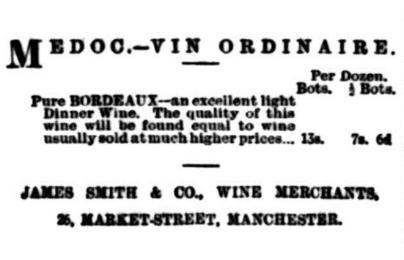.jpg)
Elizabeth Smith (d.1927)
Elizabeth Smith was an important contributor to the development of the museum at the Institute of Archaeology. She was the wife of another benefactor, James, and from 1908 both of them sat on the General Committee. James (1831–1923) was a wine and spirits merchant, who was born in Paisley, Scotland, the son of John and Margaret (née Bryce). In 1836, the family moved to Kingstown, County Dublin, and in 1851 came to Liverpool.[1] James managed to build a successful business – but did experience a shock with the failure of Barnes Bank. The headquarters of his business was at Central Buildings, North John Street, and he also had outposts in Manchester and Birmingham.[2] Elizabeth and James Smith lived together at The Knowle, a house in Blundellsands, Crosby.

A typical newspaper advert for James Smith & Co.[3]
Elizabeth is credited on a number of occasions with helping arrange the museum collections. She assisted in organising the finds from Meroë in 1910, and in 1911 the Annual Report noted: “Mrs James Smith has devoted much time to the classification and arrangement of antiquities, both in the Department and at the Museums.”[4] Her husband was an art collector and gave much to various institutions during his life, and after his death. For instance, in 1895 he gave a drawing by William Holmes Sullivan entitled Calpurnia Entreating Caesar not to attend the Senate to the Walker Art Gallery.[5]
After James’ death in 1923, he bequeathed most of his personal art collection to the Walker Art Gallery. This included: 30 pictures and drawings by George Frederic Watts, four sculptures by Auguste Rodin, three pictures by Adolphe Monticelli, 100 watercolours and six oil paintings by Daniel Alexander Williamson, three pictures by William Lindsay Windus, engravings by Albrecht Durer, and etchings by Seymour Haden, J. McNeill Whistler, and Samuel Palmer. Following the bequest, Herbert R. Rathbone told the Liverpool Echo: “The first time I went to Mr Smith's houses and saw these Williamson pictures I was simply amazed at them. I did not know their authorship, and thought at first that they were by Turner. Then Mr Smith explained to me that they were by Williamson, of whom, up to that time, I had never heard. Mr Sydney Jones, who also saw the pictures, was impressed by them in exactly the same way. When the public of Liverpool and the country in general have the opportunity to seeing these pictures all together I have little doubt they will form the same opinion of them as was formed by Mr Smith and confirmed by G. F. Watts and Jozef Israëls.”[6]
James’ total estate was valued at £122,510. Other than his bequest to the Walker, he set up two scholarships called Margaret Bryce Scholarships, one for local children at Liverpool Institute schools, and another for local children attending the University of Liverpool. Part of his will was only to become operative on Elizabeth’s death, which occurred in 1927.[7] The following year, his book collection was donated to the University of Liverpool Library: 850 books and some manuscripts in total, which are now held in Special Collections and Archives.[8] In addition, his archaeological collections were left to the Institute of Archaeology. The objects came almost exclusively from excavations by Garstang, and therefore had a recorded history. It was noted that “the quality of the collection is very high.” It contained “a fine series of scarabs, beads and amulets, and, above all, a series of large gold earrings from an untouched Eighteenth Dynasty tomb at Abydos.”[9]
The Annual Report recorded the following tribute to Elizabeth Smith in 1927:
By the death of Mrs Smith the Institute has suffered a great loss. From the year 1909 she had been an active member of the Committee of the Institute in which she manifested her interest in many ways. After visiting with her husband the excavations at Abydos in 1907 she gave consistent assistance to the care and classification of the Egyptian antiquities that accrued to the Institute as a result, and the number of these will now, in accordance with her late husband’s will and her personal wish, be greatly increased by the addition of many choice specimens, which will be found duly labelled and in good condition thanks to the care she bestowed upon them. To the Department of Methods and Practice in Archaeology she gave help assiduously and unstintingly for many years and of late had undertaken, and completed before her death, the entire arrangement and indexing of the photographs and lantern slides belonging to that Department.[10]
[1] HJ Tiffen 1935 A History of the Liverpool Institute Schools, 1825–1935. Liverpool: Liverpool Institute Old Boys’ Association, 158
[2] Liverpool Echo, 16 April 1923
[3] Sporting Chronicle 28 October 1896 p1
[4] PUB/2/2/1/1 Annual Report 1910–11, p11 and PUB/2/2/1/1 Annual Report 1911–12, p18
[5] Globe, 19 June 1895
[6] Liverpool Echo, 29 June 1923
[7] Yorkshire Post, 6 July 1923
[8] Special Collections and Archives n.d. James Smith Books. https://libguides.liverpool.ac.uk/library/sca/jamessmith
[9] PUB/2/2/1/3 Annual Report 1928, p15
[10] PUB/2/2/1/3 Annual Report 1927, pp18-19
A significant number of the Garstang Museum's Sudanese arefacts came to us through the James and Elizabeth Smith Collection, including the wooden sundial which the museum logo is drawn from.